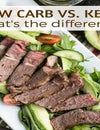No products in the cart.

If you've done other weight loss programs that restricted calories and fats...the first thing you need to do is get that out of your head. The Ketogenic Program goes again all of those rules. You WILL eat healthy fats, you will NOT count calories, you will eat when you're hungry and lose weight!
Here are somethings you'll want to remember (and do). Firstly, I recommend using an app to keep up with your carbs. My Fitness Pal, My Net Diary, etc. I'm testing out one called MyKeto on Apple. It's $3.99 for the full version (which doesn't include all the recipes), but I do like it so far.
A ketogenic diet is a type of low carbohydrate diet that is high in fat, moderate in protein and low in carbs. Typically, the macronutrient ratio in terms of calories sits within the following ranges:
••60-75% of calories from FAT (or even more)
••15-30% of calories from PROTEIN
••5-10% of calories from NET CARBS
••60-75% of calories from FAT (or even more)
••15-30% of calories from PROTEIN
••5-10% of calories from NET CARBS
How many net carbs should you have?
Net carbs are total carbs minus fiber. So if you're looking at the package below, the NET carbs are 3g per serving.
| Nutritional Facts Serving Size: 1/4 cup (28g) Servings Per Container: 16 | Amount Per Serving | % Daily Value |
|---|---|---|
| Total Carbohydrate | 6 g | 2 % |
| Dietary Fiber | 3 g | 12 % |
| Sugars | 1 g | N/A |
| Protein | 6 g | 12 % |
It is ideal to keep your daily net carbs below 50g daily. For the purposes of this program and healthy weight loss, 20-35g is ideal. Some people need more carbs so you will need to increase your carb count slowly (not to exceed 50g) to determine which works best for your body.
How much PROTEIN should you eat?
You will want to keep your protein intake moderate. Your body fat percentage determines the optimal protein intake (0.6 to 1 grams per pound / 1.3 to 2.2 grams per kg of lean body mass). Use this protein calculator, to find the protein intake that is right for you.
Increase the proportion of calories that come from healthy fats (monounsaturated, omega 3s, saturated). Limit your consumption of fruits to coconut, avocado and a small amount of berries. Also, avoid eating low-carb treats if they trigger cravings.
Eat when you are hungry, even if it’s a meal a day. Don’t let others dictate what you eat or how often you eat. You don’t have to limit quantities of food deliberately, but you should stop eating when you
feel full, even if the plate is not empty - keep it for later.
feel full, even if the plate is not empty - keep it for later.
DON'T COUNT CALORIES - listen to your body needs. Ketogenic and low-carb diets have a natural appetite control effect and you will eat less.
Keep an eye on your calorie intake only if you reach a weight loss plateau - use KetoDiet Buddy to find your ideal macros.
Increase the quantity of water you drink - at least 2-3 litres a day.
Make sure you avoid all processed vegetable oils, margarine, hydrogenated oils, partially hydrogenated oils, trans fats, soybean oil, corn oil, grapeseed oil, and canola oil.
Don’t be afraid of saturated fat and use it for cooking (coconut oil, ghee78, lard, tallow, palm oil - organic from sustainable agriculture). Use unsaturated fats for salads (olive oil, nut oils, sesame oil, flaxseed oil, avocado oil - organic, extra virgin). Some can be used for light cooking.
MAKE SURE TO PLAN YOUR MEALS. THIS IS MORE SUCCESSFUL WHEN YOU PLAN.
Look out for more tips to be successful on this plan...coming soon.
Leave a comment






